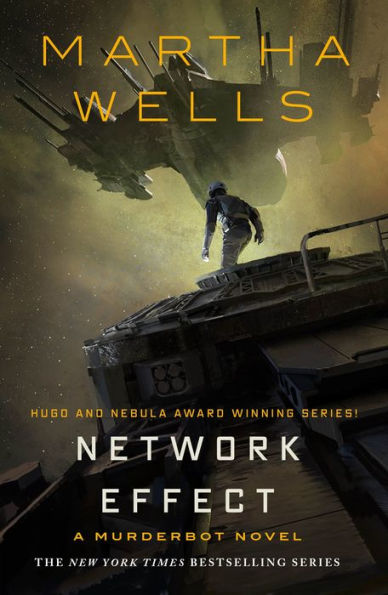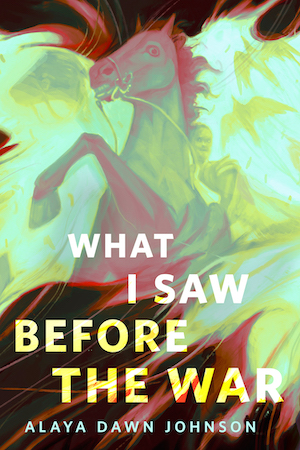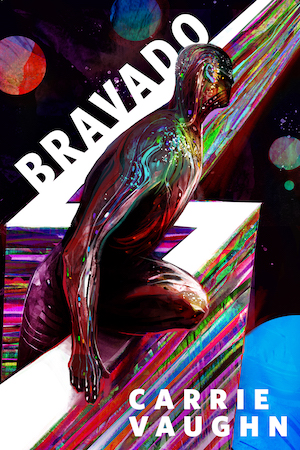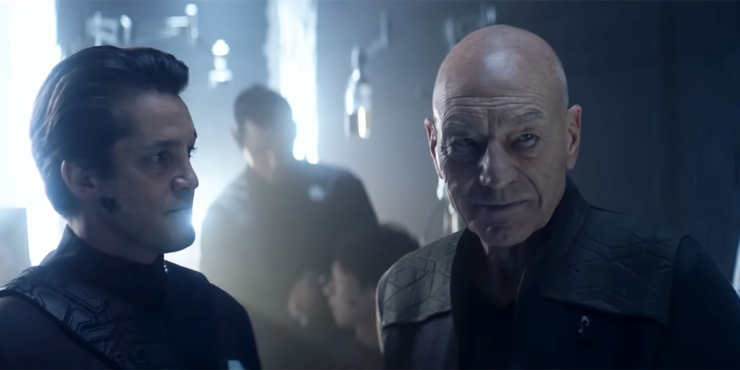Before we get into the review of this week’s Picard, I just want to comment on the hilarious serendipity of “The Impossible Box” using the Sikarian spatial trajector, introduced in “Prime Factors,” a first-season episode of Voyager that I just covered a week ago in my rewatch of that show, as a plot point. I also must confess to getting a certain sadistic glee out of the fact that the Sikarians were assimilated by the Borg, as they were a generally skeevy people. (Okay, that’s not fair, we only really met three of them, and only two of those three were skeevy, but still.)
Anyhow, that was a wonderfully unexpected surprise, and one that actually worked. And it was just one of many great things about “The Impossible Box,” which is the best episode of Picard so far (and I’m happy to keep saying that each week if the quality keeps improving week to week).
Let’s start with my one disappointment in the episode: Jurati receives precisely no punishment for her cold-blooded murder of Bruce Maddox at the end of “Stardust City Rag.” But it also looks like everyone is taking her word for what happened—that his heart just gave out from his injuries. It’s a perfectly plausible cause of death, and given that this is a civilian ship with only really one person on the crew, I’m willing to accept it for the nonce. We don’t see any of the Emergency Holograms in this episode—it’s actually the first episode Santiago Cabrera appears in only as Rios and not any of his lookalike holos—so the ignorance of the rest of the gang is forgivable so far. But only so far, and only for so long. (No, I’m not letting this go. Jurati is a murderer, period.)
The one good thing I will say about it is that Alison Pill’s performance remains superb. She’s obviously a complete mess over this, and it’s easy enough for everyone to think of it as trauma from losing someone she loved rather than trauma from killing someone she loved. I especially liked her line to Rios about how her super power is to detect herself making mistakes as she makes them.
Buy the Book


Network Effect
Although her PTSD is as nothing compared that of our title character, who gets to board a Borg Cube for the first time since he was transformed into Locutus of Borg in “The Best of Both Worlds.” As we saw in many places—“Family,” “I, Borg,” First Contact, and just last week in “Stardust City Rag”—the trauma of assimilation has not gone away, only receded into the background. Heading to the Artifact, as it’s called, brings it to the foreground in a nasty way.
Director Maja Vrvilo does excellent work here, augmenting the script by executive story editor Nick Zayas in showing Picard’s trauma. It begins with the discussion of the Borg among Picard, Jurati, and Elnor, which Sir Patrick Stewart plays magnificently, and for which Vrvilo shoots Stewart in extreme closeup so we can see the trauma etched on his pained face. It’s not as intense as, say, his conversation with Lily Sloane in First Contact, but while Picard is better than he was, he’s still not good. (His line about how the Borg don’t change, they metastasize is brilliant.)
And as soon as he beams aboard the Artifact, he starts having flashbacks. My favorite was the way Vrvilo blocks the XBs (ex-Borg) who grab him to keep him from falling off one of the Cube’s massive catwalks—it’s done in exactly the same manner as the way the Borg drones “escorted” Picard on the Cube when they kidnapped him in “The Best of Both Worlds.”
Picard is only able to board the Cube thanks to the awesomeness of his erstwhile aide. Michelle Hurd turns in another brilliant performance, as Musiker is asked to convince Captain Emily Bosch, an old friend of hers, to grant Picard diplomatic access to the Artifact. The expert manner in which Musiker gets the access—even though it means burning the friendship with Bosch—is contrasted perfectly with how she falls apart as soon as she’s done, ignoring the applause of the rest of the gang. That applause is deserved, mind you, as Musiker’s manipulation of Bosch is brilliant, thanks in part to her easy charm, and also due to her use of Picard’s dual reputations as a great captain (Musiker jokes that his face is probably still on the brochures) and as a self-righteous pain in the ass.
Musiker is spectacularly broken, and Rios—her old friend, and Cabrera and Hurd play that friendship with nary a false note—is the only one who seems to even notice. We find out that her neglect of her son extends beyond her direct relationship with him: in all the years she’s known Rios, this is the first she’s told him that she even has a son, much less a daughter-in-law she’d never met before and an impending granddaughter she will likely never ever meet. Hurd absolutely nails the disconnect between Musiker’s completely together professionalism with her trash fire of a personal life. As Rios says, “Nobody gets it all right, Raff.” Truer words, man…
On the Artifact itself, Narek’s long game is finally paying off, as Soji has been having the same dream over and over. The very notion of a synth dreaming seems absurd to Narek, and also to Rizzo (who is ready to pull the plug on her brother’s operation and kill Soji, but Narek insists on patience so they can find the synth’s home world). Where Rizzo thinks it’s a malfunction, Narek thinks it’s the way her positronic brain is trying to reconcile her cover story of being human with the reality of her being a synth. He helps it along by pointing out to Soji that every time she contacts her mother to talk, the communication lasts exactly 70 seconds. Soji finds this impossible to credit, and then she examines all her personal items and is appalled to realize that they’re all 37 months old. (On the one hand, this seems like a mistake on Maddox’s part. On the other hand, how often does someone scan their personal effects to see how old they are?) The Mom AI does its best to keep Soji on point, but the deception is starting to crumble.

Then Narek brings her to a meditation chamber—one that is forbidden to non-Romulans, but he uses his Tal Shiar clout to let her in—and he gets her to examine the recurring dream. Eventually, they get enough details to know what planet it is, and while Rizzo goes to search for a planet with thunderstorms and two red moons, Narek traps Soji in the meditation chamber with a radiation bomb. (Is it a thalaron device like the one used to turn the Romulan senate to pixie dust in Nemesis?) But before Soji can be killed by it, she pounds through the deck to escape, having been activated and is now Full Android.
Narek is as pained by the need to kill Soji as Jurati was by the need to kill Maddox, but in his case, the issue is that he has any reticence to kill her, since he’s supposed to be a badass member of the Romulan not-so-secret police. He really has fallen in love with the synth, and it makes it much harder to betray and (try to) kill her. Unfortunately, Harry Treadaway’s don’t-hate-me-because-I’m-beautiful mien is less well suited to Narek’s pain, so it’s less effective than Jurati’s trauma, but it is there.
Meanwhile, Picard for the first time in this series so far has a reunion with someone who’s actually glad to see him. Hugh remains grateful to Picard for freeing him from the Collective and saving him from Lore, and the hug they share is lovely. Hugh gives Picard access to the Artifact and helps him find Soji and then escape with her. Before he does that, Hugh shows Picard the work they’re doing in rescuing Borg from assimilation. Seeing that pleases Picard—it’s not as if the notion is completely foreign, as Hugh and Seven of Nine and Picard himself are all proof of, but seeing it on this scale is heartening. Picard comments that this will help people see the Borg as victims rather than monsters, an attitude that Picard himself could have used in “I, Borg” and First Contact…
I didn’t think much of Isa Briones as Dahj, but her Soji is much better. I like how she plays the growing frustration with the contradictions in her life, and I especially like that she’s very hesitant to go with Picard. Indeed, one suspects that him holding Dahj’s necklace is the only reason she even listens to him, and she very obviously doesn’t trust him all that much.
Once Narek sounds the alarm, beaming back to La Sirena stops being an option, but Hugh has another one: the trajector, which is in the Queen’s alcove. There’s a great moment here where Picard recognizes it instantly despite never having been in one, and Hugh mentions that he’s never been in one either, but knew exactly where it was and what it looks like—that’s the reality of assimilation, there’s all this knowledge of the Borg that’s just there. We’ve seen this before, as Picard has been able to put that to good use in “I, Borg,” the “Descent” two-parter, and First Contact. And, in a nice touch, Soji instantly recognizes the trajector and knows that it has a range of 40,000 light-years, because now that she’s activated, she has access to all kinds of data, including Voyager’s logs, presumably.
The other assistance comes from Elnor, who beams to the Cube against Picard’s instructions. (Elnor’s trademark Qowat Milat honesty provides an amusing exchange: “Elnor, I told you to stay on the ship.” “Yes. I didn’t listen.”) The final shot is Elnor with sword raised, defending Hugh from the Romulans who have come to get Soji back (and boy will they be confused).
This episode has everything: pathos, action, revelations, character development, attempts to move past trauma (with varying degrees of success), and just some great performances by almost everyone. Treadaway and Peyton List are still doing their Lannister act as the Romulan siblings and it’s tiresome. It’s only even watchable because the plot hasn’t called for them to be in any scenes with the superior actors in the rest of the cast beyond Briones and Tamlyn Tomita, but if that changes, it’s going to be cringeworthy. Everyone else, though, is nailing it, even Cabrera, who shows us Rios’s tender side as well as his horn dog side (he has no hesitation when Jurati comes on to him, even though he probably should, especially when she herself calls it a mistake).
The title is perfect, as there are three impossible boxes here: the Artifact, which remains a contradiction, a relic of a fearsome power that is nonetheless now a place of healing and research; the tan zhekran, the puzzle box that Narek uses and that Rizzo hates; and Soji herself, a “box” of locked possibility and false memories.
And each of these boxes is opened and the tan zhekran isn’t the only thing that has a prize inside. Picard boards the Artifact and finds the last thing he expected to see in a Borg Cube: hope. (He also finds who he’s looking for in Soji.) Narek is able to open his tan zhekran, unlike his sister, because he has patience, and gets the little prize inside it, which is a Romulan figure in his quarters and a radiation bomb in the meditation chamber. And Soji unlocks her true potential, and now knows what she is.
Next week, we’ll find out why Picard wanted to go to Nepenthe in particular, and also see if La Sirena can actually get away from the Artifact in one piece…
Keith R.A. DeCandido is a guest at Pensacon 2020 this weekend, spending most of his time at Bard’s Tower alongside fellow scribes Brian Anderson, Kevin J. Anderson, Jim Butcher, Michelle Cori, Phil Foglio, Charles E. Gannon, JB Garner, Andrew E. Gaska, Marion G. Harmon, Kevin Ikenberry, Megan Mackie, and Jody Lynn Nye.










